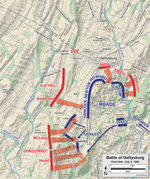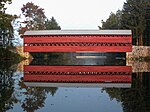Alabama State Monument
1933 establishments in Pennsylvania1933 sculpturesAlabama in the American Civil WarBronze sculptures in PennsylvaniaConfederate States of America monuments and memorials in Pennsylvania ... and 4 more
Gettysburg Battlefield monuments and memorialsOutdoor sculptures in PennsylvaniaSculptures of men in PennsylvaniaSculptures of women in Pennsylvania

The Alabama State Monument, also known as the Alabama State Memorial, is a monument which is located in the Gettysburg National Military Park. It memorializes the Confederate units from Alabama that took part in the Battle of Gettysburg.
Excerpt from the Wikipedia article Alabama State Monument (License: CC BY-SA 3.0, Authors, Images).Alabama State Monument
South Confederate Avenue,
Geographical coordinates (GPS) Address External links Nearby Places Show on map
Geographical coordinates (GPS)
| Latitude | Longitude |
|---|---|
| N 39.786388888889 ° | E -77.254166666667 ° |
Address
State of Alabama
South Confederate Avenue
Pennsylvania, United States
Open on Google Maps









